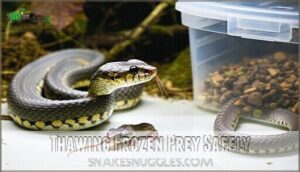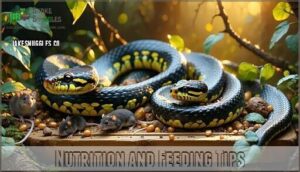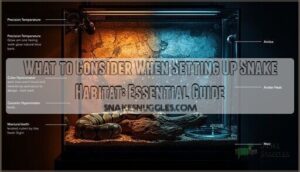This site is supported by our readers. We may earn a commission, at no cost to you, if you purchase through links.

These pre-killed rodents provide complete nutrition while eliminating the risk of bites or parasites that live prey can carry.
Choose prey that’s roughly the same width as your snake’s thickest body section – think "snug fit, not stuffed sausage."
Feed juveniles every 5-7 days and adults every 10-14 days.
You can occasionally offer rats for variety, but mice remain the gold standard.
The right feeding approach involves more than just tossing dinner in the tank.
Table Of Contents
- Key Takeaways
- Feeding Corn Snakes
- What to Feed Corn Snakes
- Feeding Frequency Matters
- Safe Feeding Practices
- Nutrition and Feeding Tips
- Frequently Asked Questions (FAQs)
- What can I feed my corn snake if I don’t have mice?
- How often do I need to feed a corn snake?
- What can I feed my snake instead of mice?
- Can corn snakes eat fruits?
- What can I feed my corn snake?
- Should you feed a corn snake in its cage?
- What to avoid with corn snakes?
- How can I tell if my snake is hungry?
- Is it okay to handle snakes before feeding?
- What other pets can I keep with corn snakes?
- Conclusion
Key Takeaways
- You’ll want to feed frozen-thawed mice as your primary food source – they provide complete nutrition while eliminating the risks of bites or parasites that come with live prey
- Choose prey that’s roughly the same width as your snake’s thickest body section – proper sizing prevents regurgitation and ensures safe digestion without overfeeding
- Feed juveniles every 5-7 days and adults every 10-14 days – younger snakes need more frequent meals to support their rapid growth, while adults require less frequent feeding
- Always use feeding tongs and thaw prey safely – this prevents accidental bites during feeding and eliminates harmful bacteria by properly thawing frozen prey at room temperature rather than using hot water or microwaves
Feeding Corn Snakes
Feeding your corn snake correctly is essential for maintaining its health and ensuring proper growth throughout its life.
You’ll need to provide appropriately sized prey items, typically mice, on a regular schedule that matches your snake’s age and size, which is crucial for its overall growth.
Prey Size and Types
When choosing prey for your corn snake, size matters more than you’d think.
Select prey items that match your snake’s widest body section—typically no larger than 1.25 times this diameter.
Frozen prey offers safer meal planning than live rodents, reducing injury risks.
Proper feeder size guarantees healthy snake nutrition and prevents dangerous regurgitation or digestive complications.
Many snake owners rely on frozen mouse prey options for convenient feeding.
Mice and Rats as Primary Food Sources
Mice serve as your corn snake’s primary food source due to their ideal rodent nutrition profile and availability.
You’ll find frozen prey from reputable mouse breeding facilities offers consistent rat sizing and eliminates disease risks.
Adult corn snakes thrive on appropriately-sized mice following a structured snake feeding schedule, making mice the cornerstone of any effective corn snake diet plan for healthy feeding habits.
Understanding proper prey size selection is essential for a balanced and healthy diet.
Alternative Prey Options
While rodents remain the gold standard for corn snake nutrition, you can offer prey variety through several feed alternatives.
These wild foods mirror natural snake feeding patterns and provide nutritional enrichment for your pet.
Here are five alternative prey options for corn snakes:
- Quail chicks – Frozen commercially available birds that many snakes readily accept
- Quail eggs – Small eggs that provide dietary variety but shouldn’t replace whole prey
- Reptilinks – Ground whole prey blends containing birds, rabbits, and frogs
- Green anoles – Occasional lizard prey for enrichment and sensory stimulation
- Button quail – Another avian option from reptile food suppliers
These snake nutrition alternatives work best as supplements to your regular frozen thawed prey routine rather than complete replacements.
For ideal health, understanding proper feeding techniques is essential to prevent health issues in corn snakes.
Importance of Captive-Bred Prey
Captive-bred prey offers superior quality compared to wild-caught alternatives.
Captive-bred rodents deliver consistent nutrition without the disease risks of wild prey.
These breeding methods guarantee your corn snake receives consistent snake nutrition without parasites or diseases.
Quality captive care facilities produce healthier food sources, supporting proper reptile nutrition.
Your corn snake food choices directly impact feeding ethics – captive-bred options reduce environmental impact while providing safer meals for ideal snake feeding guide recommendations, which is a result of proper reptile nutrition.
What to Feed Corn Snakes
For ideal snake nutrition, your corn snake’s diet centers on whole prey that mirrors their natural feeding patterns. Frozen-thawed rodents provide the safest and most convenient option for pet snake food while meeting all nutritional requirements.
Essential Prey Selection Guidelines:
- Mice – Primary food source for corn snakes of all ages
- Rats – Suitable for larger adult snakes requiring bigger meals
- Frozen-thawed prey – Safer than live feeding, reduces injury risk
- Appropriately sized prey – No wider than 1.5x snake’s mid-body diameter
- Captive-bred rodents – Eliminates parasites and diseases from wild prey
Proper meal planning involves selecting prey that matches your snake’s current size and growth stage. Using feeding tools like forceps prevents accidental bites during meal time. Quality corn snake food supports digestive health when you choose reputable suppliers.
Your snake feeding guide should prioritize whole prey over processed alternatives, as this approach delivers complete nutrition naturally. Understanding proper feeding schedules is vital for maintaining your pet’s long-term health. Remember, consistency in prey selection helps maintain your pet’s long-term health.
Feeding Frequency Matters
Getting the feeding schedule right is essential for your corn snake’s health and growth.
You’ll need to adjust how often you feed based on your snake’s age, with younger snakes requiring more frequent meals than adults, which is a complete concept to consider for their health.
Hatchlings and Juvenile Feeding Schedules
Young corn snakes grow rapidly and need frequent meals to fuel their development.
Hatchlings require feeding every 5-7 days, while juveniles can go 7-10 days between meals.
| Age Group | Feeding Frequency | Prey Size | Growth Rate |
|---|---|---|---|
| Hatchlings | Every 5-7 days | Pinky mice (1-3g) | 5-15g/month |
| Early Juveniles | Every 7 days | Fuzzy mice (3-5g) | 10-20g/month |
| Late Juveniles | Every 7-10 days | Hopper mice (5-7g) | 15-25g/month |
The feeding frequency and prey size are crucial for the growth rate of young corn snakes.
Subadult and Adult Feeding Schedules
Once your corn snake reaches subadult size (around 18 months old), you can space out feeding intervals to every 7-10 days.
Adult diets require less frequent meals than juveniles since their growth rate slows substantially.
Follow these feeding guidelines: offer appropriately sized prey based on your snake’s girth, not length.
Proper subadult care means monitoring body condition between feedings, and this corn snake feeding schedule promotes healthy snake nutrition without overfeeding risks, ensuring a good body condition.
Adjusting Feeding Frequency for Weight Management
Weight control requires monitoring your snake’s body condition and adjusting corn snake feeding frequency accordingly.
Adult snakes showing excess weight should switch to feeding schedules with longer intervals between meals. Growth rates slow when you reduce meal frequency, preventing obesity while maintaining proper snake nutrition requirements.
Regular weight checks help create effective meal planning strategies for ideal reptile feeding guidelines.
Safe Feeding Practices
You’ll need to handle prey safely to protect both yourself and your snake from injury or disease.
Proper thawing and feeding techniques prevent bacterial contamination and guarantee your corn snake gets complete nutrition from each meal.
Handling Prey With Forceps or Tongs
Always use feeding tools when offering prey to your corn snake. Forceps or tongs create safe distance between your hands and your pet’s striking zone.
Long-handled tongs work best for larger snakes, while shorter forceps suit smaller specimens. This prey handling technique prevents accidental bites and reduces stress for both you and your snake during feeding time.
Proper handling techniques involve following safe snake feeding practices, including prey selection guidelines.
Thawing Frozen Prey Safely
Proper frozen prey thawing prevents bacterial growth and guarantees your snake’s safety.
Never use hot water or microwaves, which create dangerous hot spots. Instead, move frozen thawed prey from freezer to refrigerator overnight, then bring to room temperature before feeding.
This gradual thawing method maintains prey storage integrity while supporting corn snake diet requirements through safe handling practices.
Using a frozen prey thawer involves understanding frozen prey safety to minimize risks and ensure a healthy diet for your corn snake.
Avoiding Incomplete Meals and Harmful Bacteria
When bacterial contamination strikes, you’re playing with your snake’s health.
Remove uneaten prey within 24 hours to prevent harmful bacteria growth that causes digestive issues.
Practice sanitary handling techniques and maintain food safety standards during feeding sessions.
Monitor meal balance carefully—incomplete meals disrupt corn snake diet patterns, and healthy feeding requires proper snake feeding safety protocols and attention to reptile nutrition guide recommendations for ideal snake nutrition facts.
Nutrition and Feeding Tips
You’ll need to provide proper nutrition to keep your corn snake healthy throughout its life.
Creating the right feeding environment and supporting digestion guarantees your pet gets the maximum benefit from each meal, which is crucial for maintaining a healthy life.
Calcium and Multivitamin Supplements
Most corn snakes get adequate calcium from prey bones, but you might dust frozen-thawed mice with calcium powder occasionally.
Mix equal parts calcium and multivitamin supplements for dietary additives. Replace supplements every six months since vitamins degrade over time.
Breeding females and juveniles benefit most from these mineral balance boosters for proper snake nutrition.
To guarantee proper care, consider the snake care guidelines when planning their diet and environment.
Importance of Balanced Nutrition for Corn Snakes
While supplements aren’t typically necessary, balanced nutrition forms the foundation of your corn snake’s long-term health and vitality.
Meeting specific nutrient requirements through whole prey supports healthy snake health and prevents common dietary issues.
- Complete proteins from whole rodents provide all essential amino acids for growth
- Proper calcium-to-phosphorus ratios in prey prevent metabolic bone disease
- Dietary variety between mice and rats ensures thorough reptile nutrition coverage
Following established feeding guidelines helps avoid digestive issues while maintaining your snake’s natural feeding responses.
Understanding the correct corn snake feeding schedule is essential for a healthy pet.
Using a Feeding Tub for Meal Time
A dedicated feeding-tub creates a controlled environment for safe corn snake meals. You’ll prevent substrate ingestion and reduce feeding aggression when using this simple setup.
| Setup Component | Best Practice | Safety Benefit |
|---|---|---|
| Tub Placement | Quiet, secure location | Reduces stress during feeding |
| Feeding Tools | Use tongs for prey handling | Prevents accidental bites |
| Tub Cleaning | Sanitize after each meal | Eliminates harmful bacteria |
Choosing the right equipment, such as a feeding tub product, is essential for a successful feeding experience. Choose an appropriately sized container for meal timing success. Snake feeding safety improves dramatically with proper tub cleaning protocols and strategic feeding tools placement.
Maintaining a Temperature Gradient for Digestion
Proper thermal gradients transform your corn snake’s digestion from sluggish to stellar.
You’ll need heat sources creating belly heat ranging from 88-92°F on the warm side to 75-80°F on the cool side for ideal digestion rates.
- Temperature control prevents regurgitation – incorrect thermal gradients can cause your snake to vomit undigested meals
- Belly heat accelerates metabolism – under-tank heaters boost digestion rates faster than overhead lighting
- Consistent gradients reduce stress – stable temperatures help your snake feel secure during vulnerable feeding periods
Frequently Asked Questions (FAQs)
What can I feed my corn snake if I don’t have mice?
If you’re coping with a pinch without your snake’s usual dietary staples, you can offer frozen-thawed chicks, quail, or appropriately-sized rats as alternatives.
These options provide similar nutritional profiles to mice and guarantee your corn snake receives proper sustenance.
How often do I need to feed a corn snake?
Adult corn snakes need feeding every 7–10 days, while juveniles require meals every 5–7 days for proper growth. You’ll adjust frequency based on your snake’s age and size.
What can I feed my snake instead of mice?
While mice are the recommended primary food for corn snakes, you can offer alternative prey like rats, quail chicks, or day-old chicks occasionally.
These options provide similar nutritional value and variety.
Can corn snakes eat fruits?
No, corn snakes can’t eat fruits – they’re obligate carnivores. Their digestive systems are designed exclusively for processing whole prey like mice and rats, not plant matter.
What can I feed my corn snake?
You’ll want to feed your snake frozen-thawed mice as their primary food source.
Adult corn snakes need one appropriately sized rodent every 7-10 days, while juveniles require feeding every 5-7 days for proper growth and development.
Should you feed a corn snake in its cage?
Many snake keepers debate feeding locations, but 85% of reptile veterinarians recommend feeding corn snakes in their enclosures.
You’ll reduce stress and avoid handling risks by feeding in the cage.
Just use feeding tongs for safety.
What to avoid with corn snakes?
Avoid live prey, which poses injury risks to your snake.
Don’t handle stressed or shedding snakes.
Prevent temperature extremes, overcrowding, and feeding oversized prey that exceeds 5x your snake’s body diameter for safety.
How can I tell if my snake is hungry?
You’ll notice your snake becoming more active and exploring its enclosure when hungry. Watch for increased movement, tongue-flicking, and positioning near feeding areas around scheduled meal times.
Is it okay to handle snakes before feeding?
Like a careful gardener tends their prized roses, you’ll want to avoid handling your corn snake before feeding time.
Pre-feeding handling can trigger defensive responses, reduce appetite, and increase stress levels that interfere with proper digestion.
What other pets can I keep with corn snakes?
You shouldn’t house other pets with corn snakes. They’re solitary animals that view tank-mates as food or threats. Separate enclosures keep everyone safe and stress-free.
Conclusion
Providing proper nutrition transforms your serpentine companion from a coiled telegraph wire into a thriving predator.
Understanding what to feed a corn snake guarantees superior health throughout their 15-20 year lifespan.
Frozen-thawed mice offer complete nutrition while eliminating prey-related risks.
You’ll maintain consistent feeding schedules, proper prey sizing, and safe thawing practices.
These fundamentals create a foundation for successful corn snake ownership, supporting healthy growth and natural behaviors in captivity.
- https://www.facebook.com/feedprojects/
- https://www.instagram.com/feed/
- https://www.pinterest.com/feedprojects/
- https://docs.google.com/forms/d/1GAQr3Kn1cURCVHUA82hAga1Wv8DCH0IuqDLRUrOpN7M/viewform?ts=63f4f653&entry.1515682415=https://www.merriam-webster.com/dictionary%2Ffeed
- https://premium.britannica.com/mw-unabridged/?utm_source=mw&utm_medium=inline-def&utm_campaign=evergreen











